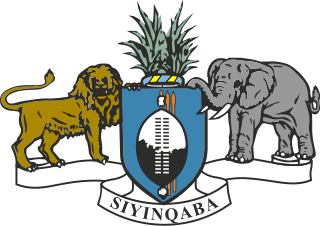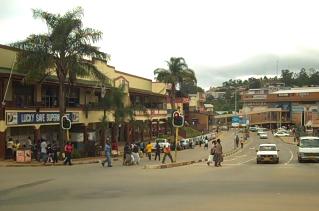
Eswatini, officially the Kingdom of Eswatini and also known as Swaziland, is a landlocked country in Southern Africa. It is bordered by Mozambique to its northeast and South Africa to its north, west and south. At no more than 200 kilometres (120 mi) north to south and 130 kilometres (81 mi) east to west, Eswatini is one of the smallest countries in Africa; despite this, its climate and topography are diverse, ranging from a cool and mountainous highveld to a hot and dry lowveld.

Eswatini is a country in Southern Africa, lying between Mozambique and South Africa. The country is located at the geographic coordinates 26°30′S31°30′E. Eswatini has an area of 17,363 square kilometres, of which 160 are water. The major regions of the country are Lowveld, Midveld and Highveld.
Public transport is the main means of transportation in Eswatini. Car ownership is low, at 32 cars per 1,000 people. The National Road Network has 1500 km of main roads and 2270 km of district roads.

Manzini is a region of Eswatini, located in the center-west of the country. It has an area of 4,093.59 km² and a population of 355,945 (2017), and is divided into 16 tinkhundla. Its administrative center is Manzini. It borders all three other regions: Hhohho in the north, Lubombo in the east, and Shiselweni in the south. It is bordered by the Mpumalanga province in South Africa to the west.

The Parliament of Eswatini is bicameral, consisting of a lower chamber and an upper one. Some of the members of both chambers are elected, while the rest are appointed by the King of Eswatini. Election is by secret ballot in a first-past-the-post system of voting. Members of both chambers serve for five-year terms. All candidates run on a non-partisan basis, as political parties are banned.

Lobamba is the traditional, spiritual, and legislative capital city of Eswatini, seat of the Parliament, and residence of the Ntombi, the Queen Mother. Mswati III lives about 10 kilometres (6.2 mi) away at the Lozitha Palace. The King and Queen Mother participate in annual December and January Incwala ceremonies and August and September Reed Dancees at the Royal Kraal.

Manzini is a city in Eswatini, which is also the capital of Eswatini's Manzini Region. The city is the country's second largest urban centre behind Mbabane, with a population of 78,000 (2008). It is known as "The Hub" of Eswatini and lies on the MR3 road. Eswatini's primary industrial site at Matsapha lies near the town's western border.

The House of Dlamini is the royal house of the Kingdom of Eswatini. Mswati III, as king and Ngwenyama of Swaziland, is the current head of the house of Dlamini. Swazi kings up to the present day are referred to as Ingwenyama and they rule together with the Queen Mother who is called Indlovukati. The Swazi kings, like other Nguni nations, practice polygamy and thus have many wives and children.
Articles related to Eswatini include:

Simunye is a sugar mill town on the lowveld in eastern Eswatini. Almost all of the residents of the town work for the Royal Swaziland Sugar Corporation's sugar mill located nearby.

The following outline is provided as an overview of and topical guide to Eswatini:
Education in Eswatini begins with pre-school education for infants, primary, secondary and high school education for general education and training (GET) - and universities and colleges at tertiary level.
Prostitution in Eswatini is illegal, the anti-prostitution laws dating back to 1889, when the country Eswatini was a protectorate of South Africa. Law enforcement is inconsistent, particularly near industrial sites and military bases. Police tend to turn a blind eye to prostitution in clubs. There are periodic clamp-downs by the police.
Ndvungunye was King of Swaziland from 1780 until his death in 1815 after succeeding his father, King Ngwane III following a very brief regency of Indlovukati LaYaka Ndvwandvwe. Very little has been recorded of the quality of leadership under his reign. Ndvungunye built his residence or Sigodlo near Mhlosheni on feet of the eMhlosheni hills in NShiselweni, the south east of modern Swaziland near Zombodze, where his father Ngwane had settled during his reign. His rule thus indicated a period of limited expansion and consolidation which is overshadowed by that of his son King Sobhuza I. The NShiselweni settlements established under his reign which he placed under the guardianship of his chief Sukumbili Mbokane would not however provide a solid foundation for the future Swazi state as indicated by attacks after his death on Sobhuza by Ndvwandvwe chiefs. Ndvungunye died around 1815 after being struck by lightning. Ndvungunye was married to Lojiba Simelane and Somnjalose Simelane. It was with the latter that he had his son Sobhuza I. Lojiba however became Queen mother as she was a senior sister to Somnjalose. Sobhuza I became the king in 1815 after the regency of Queen Lomvula Mndzebele.
The Mater Dolorosa Church or just Mater Dolorosa Parish, is the name given to a Catholic church located in the city of Mbabane, Eswatini. This just to one side of the same name Secondary and Elementary School..
SwaziBank, is a development finance institution, which doubles as a commercial bank in Eswatini. It is licensed and supervised by the Central Bank of Eswatini, the national banking regulator. As of March 2018 SwaziBank was the only indigenous commercial bank in the county, with the other three having their headquarters in neighboring South Africa.









